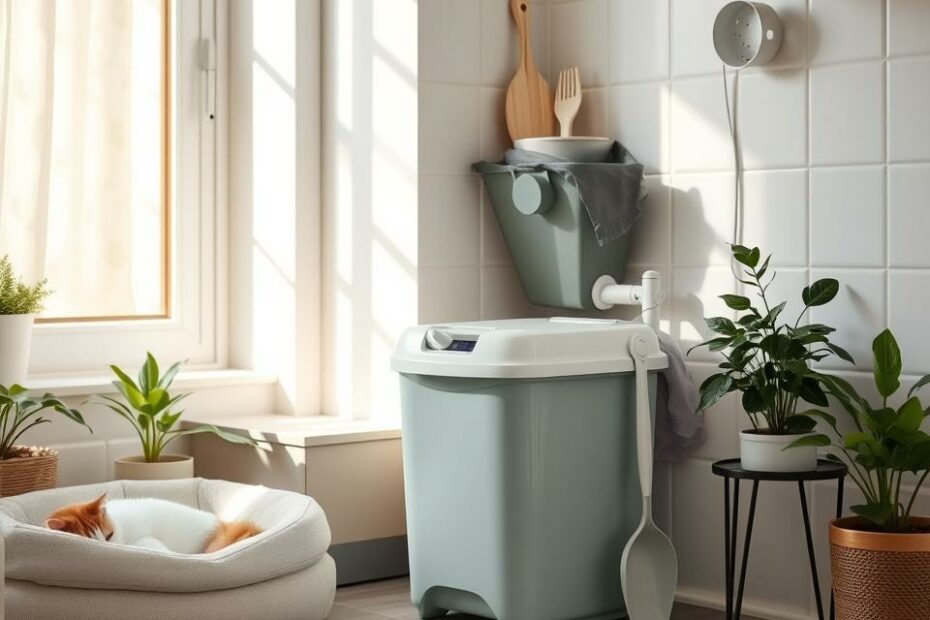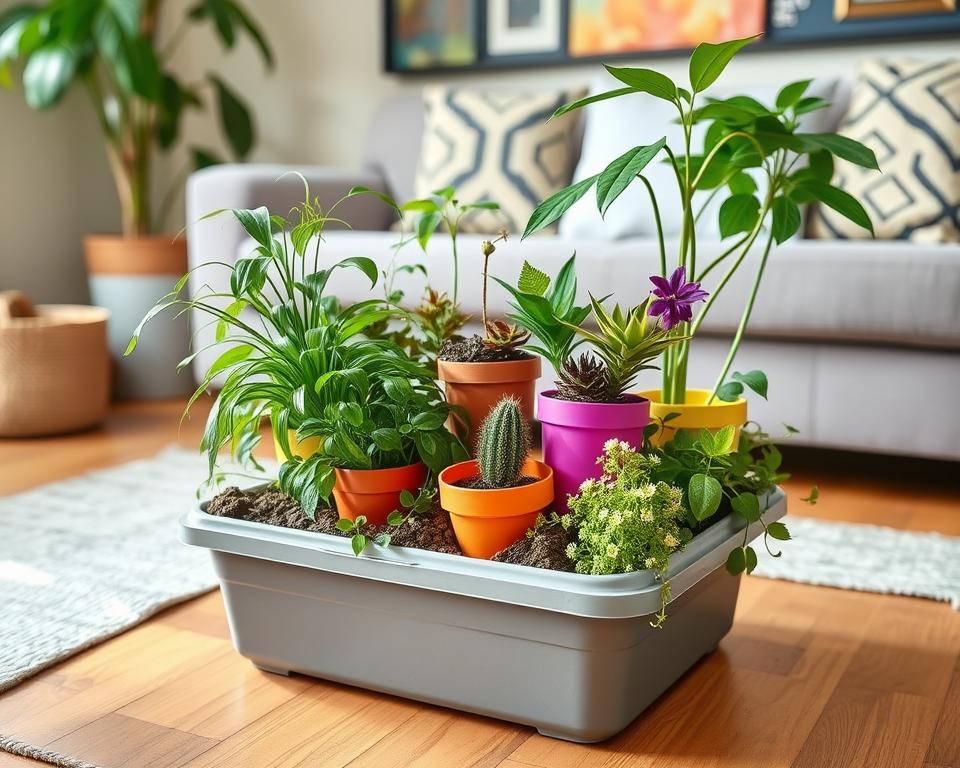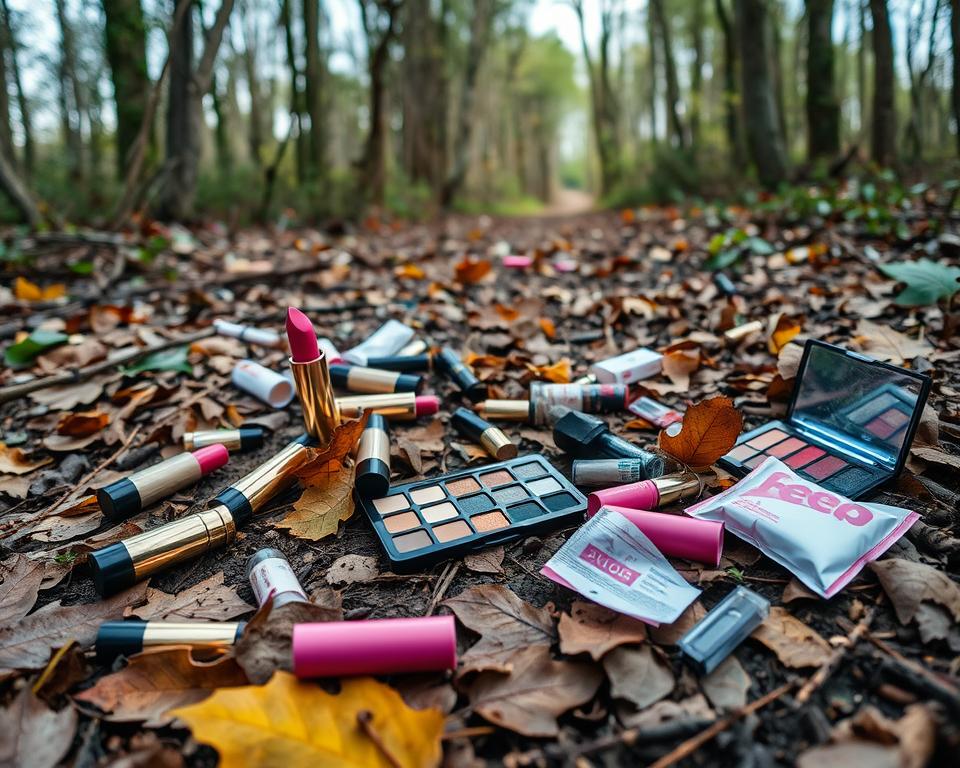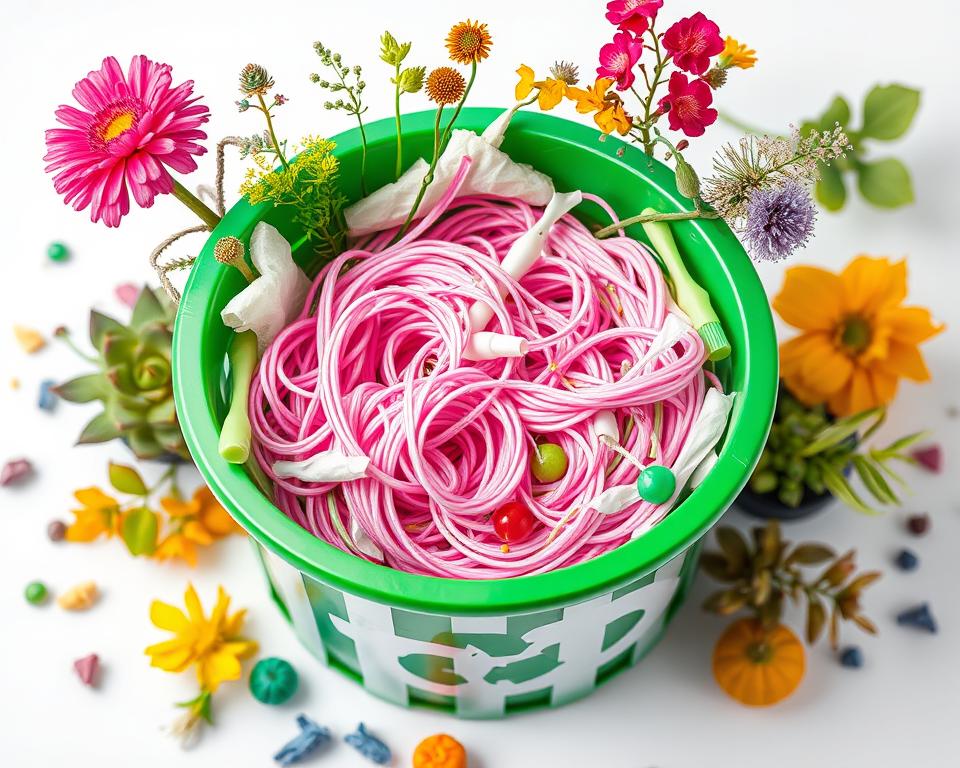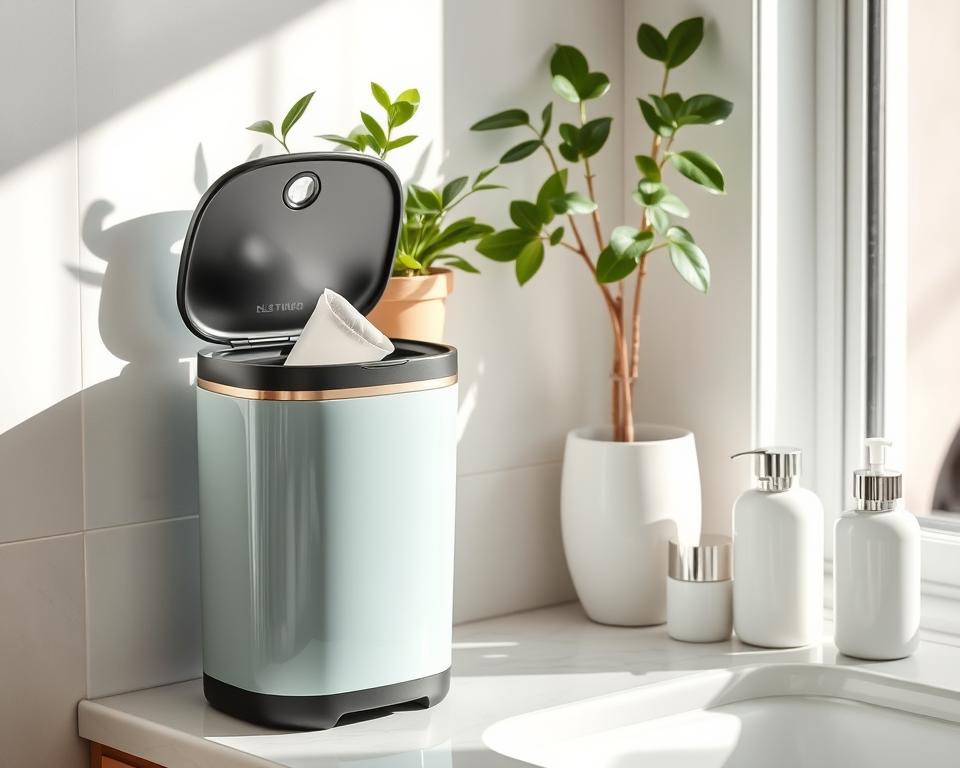A recent study found that cat owners scoop their litter boxes daily. This creates a lot of waste that needs to be handled safely. It’s important to dispose of cat litter properly to keep your home clean and odor-free. It also helps protect the environment and public health.
Key Takeaways
- Scoop litter boxes daily to maintain cleanliness
- Double bag scooped litter to prevent odor and leakage
- Avoid flushing cat litter down the toilet due to potential plumbing issues
- Biodegradable litters may pose risks if composted improperly
- Proper disposal involves tying litter bags and placing them in an outdoor trash can
Litter Box Basics Every Cat Owner Should Know
Keeping your cat’s litter box clean is key for their health and happiness. As a cat owner, knowing how to maintain the litter box is important. This includes scooping, preventing odors, and keeping bacteria at bay.
Scooping and Bagging Techniques
It’s best to scoop the litter box daily. Use a scoop to remove urine and stool clumps. Then, put these in a small trash bag or litter disposal bag.
To stop odors and bacteria, tie the bag in a knot. Then, throw it away in an outside trash can with a tight lid. It’s also smart to double-bag the litter, as clay litter gets heavy fast.
Preventing Odor and Bacterial Leakage
Keeping the litter box clean is vital for controlling smells and bacteria. Don’t just throw used litter in the trash. This can make things stinky and spread germs.
Instead, make sure the bagged litter is tightly sealed. Then, put it in an outdoor bin with a tight lid. Also, clean the litter box with warm, soapy water every week. This helps stop bacteria that cause bad smells.
By following these litter box tips, you can make a clean and comfy space for your cat. This also helps prevent health risks. Keeping the litter box clean is a big part of being a responsible pet owner.
Types of Cat Litter Materials
Finding the right cat litter can be tough. But knowing your options helps. Since 1947, clay litter has been the go-to. Now, there are many biodegradable and green choices.
Clay Litter vs. Biodegradable Options
Clay litter is still popular because it’s cheap and easy to find. But, it has silica dust, which can cause cancer. On the other hand, litters like tofu, paper, corn, and walnut shells are dust-free and better for the planet. They’re also flushable and come in different types for odor control and absorbency.
Considerations for Composting
Composting cat litter sounds good, but it’s not safe. Cat poop can have a parasite that’s bad for people, especially pregnant women. The Spruce says don’t compost cat litter, even if it’s eco-friendly. Instead, look for other ways to get rid of it, like flushing it with wood pellet litter or using eco-friendly bags.
| Litter Type | Key Features | Sustainability |
|---|---|---|
| Clay Litter | Affordable, widely available, clumping | Non-biodegradable, contains silica dust |
| Tofu Litter | Flushable, biodegradable, low-dust | Eco-friendly, made from renewable resources |
| Walnut Litter | Lightweight, eco-friendly, clumping | Biodegradable, made from natural materials |
| Corn Litter | Clumping, biodegradable, paw-friendly | Renewable, compostable |
The cat litter market is growing, offering more green choices. Each has its own benefits and downsides. By weighing these, cat owners can pick the best litter for their needs and the planet.
Dispose of Cat Litter: The Safest Method
Properly getting rid of used cat litter is key to pet waste management. The best way is to scoop the clumps into a small trash bag or litter disposal bag. Then, tie the bag and put it in an outside trash can with a tight lid. This method stops odor and bacterial leakage, which can happen if litter is just thrown away.
Don’t flush cat litter down the toilet or dump it outside. These actions can harm the environment and plumbing. For instance, cat waste contaminates groundwater, especially from outdoor cats. In coastal areas, flushing cat litter can expose sea otters to Toxoplasmosis gondii.
- Scooping clumps into a small trash bag or litter disposal bag
- Tying off the bag in a knot
- Placing the bag in an outside trash can with a tight-fitting lid
| Disposal Method | Potential Risks |
|---|---|
| Flushing cat litter down the toilet | Environmental and plumbing issues, such as contaminating groundwater and exposing sea otters to Toxoplasmosis gondii |
| Dumping cat litter outside | Environmental contamination, including groundwater pollution and harm to wildlife |
By using this safe and responsible cat litter disposal method, you protect the environment. You also keep your home clean and free of odors for you and your cat.
Never Flush Cat Litter or Waste
As pet owners, we must know the dangers of flushing cat litter or waste. Even “flushable” litter can harm your plumbing and the environment.
Risks to Plumbing and Water Systems
Flushing cat litter can cause big problems with your plumbing. Clay-based litters, silica gel litters, and even paper litters can all cause clogs and blockages in your pipes. Older plumbing systems are especially at risk because wet cat litter expands.
Also, cat waste in the litter can spread harmful parasites like Toxoplasma gondii into the water. This parasite is dangerous for pregnant women, babies, and people with weak immune systems.
- Flushing cat litter can lead to plumbing blockages and damage.
- Cat waste flushed with litter can contaminate water sources with Toxoplasma gondii, a harmful parasite.
- Septic tank systems are not designed to break down cat litter materials, leading to further issues.
To keep your plumbing and the environment safe, never flush cat litter or waste. Bag the litter and throw it away in the trash. Follow your local waste management rules.
Choosing Eco-Friendly Cat Litter
As pet owners, we must make choices that are good for the planet. When picking eco-friendly cat litter, look for biodegradable and natural materials. These options are better for the environment. Experts recommend using plant-based litters like recycled paper, wood shavings, and corn.
Traditional clay litters take a long time to break down, adding to waste. On the other hand, biodegradable litters are better for the planet. They are also healthier for your cat.
Considerations for Composting
Even though biodegradable litters are good, they might not be compostable. This is because cat waste can have harmful bacteria. Always check the safety and composting rules before composting.
| Eco-Friendly Cat Litter Options | Benefits |
|---|---|
| Recycled Compressed Paper | Biodegradable, Dust-Free |
| Wood Shavings | Biodegradable, Absorbent |
| Corn, Grass Seed, Pine, Wheat, Sawdust | Renewable, Biodegradable |
Choosing eco-friendly cat litter helps reduce our impact on the planet. It makes our homes and the world a better place for our pets.
Bagging Options for Disposed Litter
Choosing the right bag for cat litter can really help the environment. Biodegradable bags might seem green, but a 2019 study showed they don’t break down fast. Instead, brown paper bags are better because they decompose faster than plastic or biodegradable bags.
The Federal Trade Commission (FTC) has warned about false claims on pet waste bags. This means we should check the real environmental benefits of any litter bag before buying.
Evaluating Biodegradable Bag Claims
When picking litter disposal bags, don’t just look at the “biodegradable” label. We need to check how fast they break down and their environmental effect. Here are some tips for evaluating compostable claims:
- Look for certifications from groups like the Biodegradable Products Institute (BPI) or Cradle to Cradle. They check if the bag really breaks down.
- Check what the bag is made of. Choose plant-based or eco-friendly litter disposal options over plastic.
- Make sure the bag’s breakdown time and conditions match your local waste management.
| Bag Type | Biodegradability | Environmental Impact |
|---|---|---|
| Plastic Bags | Low | High |
| Biodegradable Bags | Moderate | Moderate |
| Brown Paper Bags | High | Low |
Feeding Your Cat a Nutritious Diet
Impact on Waste Composition
The quality of a cat’s diet affects their waste. Cats eating processed foods with many preservatives have waste that’s hard to break down. This waste can harm the environment, as it leads to more methane emissions.
To be more eco-friendly, it’s key to feed cats natural, minimally processed foods. This helps the environment and makes waste easier to manage.
When cats eat natural pet food with fewer additives, their waste is better for the planet. It’s easier to handle and breaks down faster. This choice helps the environment and supports sustainable pet ownership.
| Nutrient-Rich Waste | Processed Waste |
|---|---|
|
|
Choosing cat food nutrition that’s natural and less processed helps. It makes waste more biodegradable and easier to handle. This small change benefits the environment and our pets’ health.
Upcycling Litter Boxes
Many cat owners are now looking for eco-friendly litter boxes and sustainable cat ownership. They’re turning to upcycling and thrifting. Instead of buying new plastic litter boxes, they’re making their own from used plastic tubs and stainless steel containers.
Plastic comes from fossil fuels and can hold smells. It’s not the best choice for litter boxes. By using old materials, cat owners can help the planet and still give their cats a good place to go.
- Turn old plastic containers or stainless steel bowls into unique litter boxes.
- Check thrift stores and secondhand shops for items to upcycle into litter boxes.
- Get creative with DIY projects to make your cat’s litter box special. Use things like old t-shirts, wooden crates, or old furniture.
Choosing to upcycle is good for the environment and lets cat owners show their style. It’s a way to live a more sustainable cat ownership lifestyle. By being creative, cat lovers can make litter boxes that are both cool and green.
When upcycling, make sure to clean everything well. Be careful when you’re changing things to avoid dangers. With some creativity and a focus on being green, cat owners can make amazing eco-friendly litter boxes that cats will love.
Conclusion
In conclusion, the articles offer detailed advice on how to dispose of used cat litter correctly. The main points are: 1) Clean litter boxes daily and throw away the waste in the trash. 2) Don’t flush cat litter or waste down the toilet, as it can harm plumbing and water systems. 3) Choose eco-friendly, plant-based litters over traditional clay-based ones. 4) Be careful with “biodegradable” litter bag claims and use brown paper bags instead. 5) Feed cats a healthy, natural diet to make their waste easier to break down. 6) Use upcycled or thrifted containers for litter boxes instead of new plastic ones.
By following these tips, cat owners can make sure they dispose of their pet’s waste safely and responsibly. Proper disposal of cat litter is key to keeping our environment healthy and avoiding fines or legal trouble. These eco-friendly actions show that pet owners care about the planet and help make the future cleaner and greener.
FAQ
How should I properly dispose of used cat litter?
The Spruce recommends scooping out urine and stool clumps first. Then, put them in a small trash bag or litter disposal bag. Tie the bag and throw it away in an outside trash can with a tight lid. Double bagging helps prevent odors and bacteria.
Can I flush cat litter or waste down the toilet?
No, The Spruce advises against flushing cat litter or waste. It can harm water systems and plumbing. Cat waste may contain harmful parasites like Toxoplasma gondii, which is dangerous to humans and aquatic life.
What types of cat litter materials are considered more eco-friendly?
The Spruce and Treehugger say natural, biodegradable litters are better. These include recycled paper, wood shavings, corn, grass seed, pine, wheat, and sawdust. They are better than clay-based litters.
Can I compost used cat litter?
The Spruce warns against composting biodegradable litters. Cat feces can have Toxoplasma gondii, harmful to humans, especially pregnant women.
How can I choose more eco-friendly litter bags?
Treehugger suggests using brown paper bags over so-called “biodegradable” plastic bags. Many plastic bags don’t break down as fast as claimed. The FTC has warned about false claims on pet waste bags.
How does my cat’s diet impact the sustainability of their waste?
Treehugger notes that cats on processed foods produce less nutrient-rich waste. This makes waste harder to break down and increases methane emissions. Feeding cats natural, minimally processed foods is better.
What are some sustainable options for litter boxes?
Treehugger suggests using upcycled or thrifted plastic tubs or stainless steel containers. This is more eco-friendly than buying new plastic boxes.
